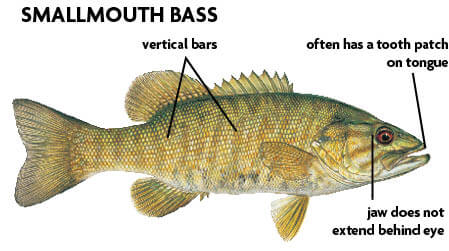Smallmouth Bass
The smallmouth bass is generally brown, appearing sometimes as black or green (seldom yellow) with red or brown eyes, and dark brown vertical bands, rather than a horizontal band along the side. There are 13–15 soft rays in the dorsal fin. The upper jaw of smallmouth bass extends to the middle of the eye. The smallmouth's coloration and hue may vary according to environmental variables such as water clarity or diet.
Males are generally smaller than females. The males tend to range around two pounds, while females can range from three to six pounds. Their average sizes can differ, depending on where they are found; those found in American waters tend to be larger due to the longer summers, which allow them to eat and grow for a longer period of time.
Their habitat plays a significant role in their color, weight, and shape. River water smallmouth that live in dark water tend to be rather torpedo-shaped and very dark brown to be more efficient for feeding. Lakeside smallmouth bass, however, that live in sandy areas, tend to be a light yellow-brown and are more oval-shaped.
They have been seen eating tadpoles, fish, aquatic insects, and crayfish.[3] There are two recognized subspecies, the Northern smallmouth bass (M. dolomieui dolomieui) and the Neosho smallmouth bass (M. dolomieui velox).
The smallmouth bass is found in clearer water than the largemouth, especially streams, rivers, and the rocky areas and stumps and also sandy bottoms of lakes and reservoirs. The smallmouth prefers cooler water temperatures than its cousin the largemouth bass, and may be found in both still and running water. Because it is intolerant of pollution, the smallmouth bass is a good natural indicator of a healthy environment, though it can better adjust to changes in water condition than most trout species. Carnivorous, its diet comprises crayfish, insects, and smaller fish, while the larvae feed on various zooplankton.

